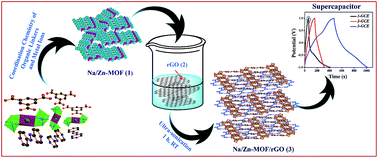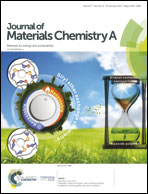Robust heterostructures of a bimetallic sodium–zinc metal–organic framework and reduced graphene oxide for high-performance supercapacitors†
Abstract
Two-dimensional (2D) mixed metal–organic frameworks (M-MOFs) have emerged as promising energy storage materials in the MOF family. Herein, we report the facile, room temperature synthesis of a Na/Zn-based bimetallic MOF, [NaZn2(μ2-BTC)2(μ2-O)2(Azopy)(H2O)2]n (1, where BTC = trimesic acid and Azopy = 4,4′-azopyridine), grown through a slow diffusion technique. The crystal structure of 1 reveals the ratio of Zn(II) to Na(I) metal ions to be 2 : 1, and the overall framework exhibits a 2D layered structure. In light of the poor conductivity of MOFs, and also to take full advantage of this 2D MOF for supercapacitor use, we assembled a unique robust heterostructure of 1 with another 2D material, i.e. reduced graphene oxide (2), using a simple-yet-effective ultra-sonication assisted approach. Electrochemical analyses reveal the notable specific capacitance (435.2 F g−1 at 1.6 A g−1) of the formed heterostructure (3), with exceptional cycling efficiency (no observed loss up to 4000 cycles in the absence of any binders). The obtained encouraging results were attributed to synergistically enhanced contributions from each participating 2D material and the formation of a robust heterostructure due to the proper stacking of the two different layered 2D materials. The results exceed those of related state-of-the-art structures and suggest the promising nomination of 2D MOFs and their heterostructures for application in the emerging world of next-generation supercapacitors.



 Please wait while we load your content...
Please wait while we load your content...